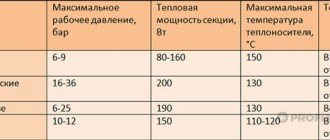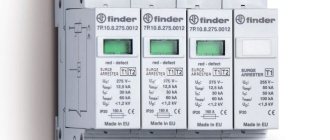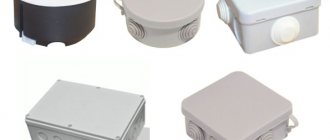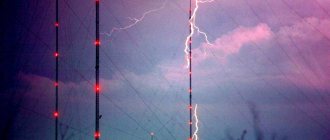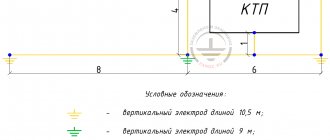Home » Electrical wiring » Lightning protection » Lightning protection of a wooden house: design and installation
When building wooden houses, many requirements must be taken into account. In addition to rotting or damage to property by rodents, wooden houses have another serious enemy - a thunderstorm. Therefore, you need to know during construction that lightning protection of a wooden house will help to reliably protect its structure.
A thunderstorm won't cause damage to your home, but lightning can. In this regard, when building a wooden house, you should be especially responsible when choosing lightning protection. Lightning protection for a wooden house should be installed at the stage of electrical installation work. To install it, you will need special equipment - a lightning rod. Typically this device is installed on the roof of a building. Its main purpose is considered to be the safe discharge of lightning charges into the ground.
Any lightning rod is actually an electrical conductor that rises high above your building. The lightning rod intentionally causes short circuits in those places where it is most needed.
What is lightning?
Many owners of private houses try to make their home as comfortable and safe as possible, but at the same time they forget about the possibility of their home being struck by lightning.
Lightning is one of the most unpleasant phenomena that can cause enormous damage to a home.
As you know, it is a high-power electrical discharge, so even if it enters the house indirectly, it can damage electrical equipment in the premises.
It is good if there is a tall building near the house, equipped with lightning protection.
In this case, you don’t have to worry about the possibility of lightning striking your house, since such houses often have lightning rods with a large protection zone, which will cover the area with adjacent buildings.
A special feature of lightning is the discharge to the highest point. Therefore, if a house is located on the outskirts, it is the highest point, unless, of course, a tree grows next to it that is taller than the house.
But wood is also not a guarantee of protection. The risk of a home being struck by lightning increases many times over if there are ponds, strong streams, or swampy areas near the house.
So, if a private house is not surrounded by high-rise buildings, it is better to protect yourself by providing your home with lightning protection.
Main types of lightning rods
Lightning protection of a wooden structure occurs thanks to lightning rods. All lightning rods that you can find on sale are divided into two types:
- Singles.
- Cable.
More information about installing a lightning rod.
Cable wires are a system of cables that must be pulled between single lightning rods. In domestic cases, they provide reliable protection of areas over a large area.
The general lightning protection system includes three elements:
- Ground electrode.
- Down conductor.
- Lightning rod.
You should not carry out lightning protection of a private home yourself. This requires appropriate experience and knowledge.
Damaging factors of lightning
But before you figure out how to protect your home from possible lightning damage, you should consider the damaging factors of this phenomenon.
There are two of these factors.
Primary.
This is a direct lightning strike on a house, as a result of which it may suffer structural damage and there is the possibility of a fire. This factor is the most dangerous.
Secondary.
Less dangerous for the home and residents. This factor comes down to the appearance of electromagnetic induction in the wiring of the house during a lightning discharge near the house.
Due to induction, a significant voltage surge occurs in the wiring, which can damage all electrical appliances in the house connected to the network.
And if you can protect yourself from the secondary factor without additional equipment by disconnecting all devices from the network during a thunderstorm, then it is impossible to protect yourself from the primary factor in this way; you need to equip your house with lightning protection.
Ohio, a house struck by lightning.
Since lightning is just an electrical discharge, albeit of great strength, it acts like any other discharge, that is, it moves along the path of least resistance.
Providing this path is the task of lightning protection.
If lightning strikes a house equipped with this type of protection, the electrical discharge will go into the ground without causing damage to the building.
Popularly, such protection is called house grounding, lightning rods, lightning rods.
As for the latter, the definition is not entirely correct, because thunder is just the sound that occurs during a lightning discharge.
Internal lightning protection of wooden buildings
Internal protection is used to prevent failure of electrical appliances. The installation is carried out by specialists. They develop an individual project and install a protection system consisting of the following elements:
- Potential equalization buses. They are responsible for maintaining optimal current in the electrical network and combine grounding electrodes and utilities.
- Surge protection device. Prevents sparks and limits electromagnetic impulses.
Criteria and types of lightning protection
Now let's look at the types of lightning protection.
Here, this equipment has several criteria that divide it into types.
The first criterion is the method of protection.
According to it, lightning rods are divided into:
- Active;
- Passive.
The active ones appeared relatively recently. They contain a lightning rod, discussed below, equipped with a special ionizer, which “provokes” lightning with its impulses.
The need for grounding
Unfortunately, electricity also has a downside. All equipment has a service life, each device has a certain reliability built into it, so they will not work forever. In addition, during the design or installation of the house itself, electrical, communications or equipment, errors can also be made that can affect electrical safety. For these reasons, part of the electrical network may be damaged. The nature of accidents can be different: short circuits may occur, which are turned off by automatic switches, or breakdowns may occur on the housing. The difficulty is that the breakdown problem is hidden. The wiring was damaged, so the body of the electric stove was energized. If grounding measures are incorrect, the damage will not manifest itself until a person touches the stove and receives an electric shock. Electrocution will occur due to the fact that the current seeks a path into the ground, and the only suitable conductor is the human body. This cannot be allowed.
Such damage poses the greatest threat to human safety, because in order to detect it early, and therefore to protect against it, it is imperative to have grounding. This article discusses what actions need to be taken to organize grounding for a private home or cottage.
The need to install grounding in a private house is determined by the grounding system, i.e. the neutral mode of the power source and the method of laying the neutral protective (PE) and neutral working (N) conductors. The type of power supply network - overhead or cable - may also be important. Structural differences in grounding systems allow us to distinguish three options for power supply to a private home:
TN-S system
Grounding system TN-S
The main potential equalization system (BPES) combines all large current-carrying parts of the building, which normally do not have electrical potential, into a single circuit with the main grounding bus. Let's consider a graphic example of implementing a control system in an electrical installation of a residential building.
First, let's look at the most progressive approach to electrical power supply at home - the TN-S system. In this system, the PE and N conductors are separated throughout, and the consumer does not need to install grounding. You just need to connect the PE conductor to the main grounding bus, and then connect the grounding conductors to electrical appliances from it. Such a system is implemented both by cable and overhead line; in the case of the latter, VLI (insulated overhead line) is laid using self-supporting wires (SIP).
But not everyone has such happiness because the old overhead transmission lines use the old grounding system - TN-C. What is its peculiarity? In this case, PE and N along the entire length of the line are laid with one conductor, which combines the functions of both the neutral protective and neutral working conductors - the so-called PEN conductor. If previously it was allowed to use such a system, then with the introduction of the PUE 7th edition in 2002, namely clause 1.7.80, the use of RCDs in the TN-C system was prohibited. Without the use of an RCD, there can be no talk of any electrical safety. It is the RCD that turns off the power if the insulation is damaged as soon as it occurs, and not at the moment when a person touches the emergency device. To meet all necessary requirements, the TN-C system must be upgraded to TN-CS.
TN-CS system
Grounding system TN-CS
In the TN-CS system, a PEN conductor is also laid along the line. But, now, paragraph 1.7.102 of the PUE 7th ed. says that at the overhead line inputs to electrical installations, repeated grounding of the PEN conductor must be performed. They are carried out, as a rule, at an electrical pole from which the input is made. When re-grounding, the PEN conductor is divided into separate PE and N, which are brought into the house. The re-grounding norm is contained in clause 1.7.103 of the PUE 7th ed. and is 30 Ohm, or 10 Ohm (if there is a gas boiler in the house). If grounding at the pole is not completed, you must contact Energosbyt, whose department is responsible for the electric pole, distribution board and entry into the consumer’s house, and point out the violation that must be corrected. If the distribution panel is located in the house, the PEN separation should be done in this panel and the re-grounding should be done near the house.
Distribution board diagram
In this form, TN-CS is successfully operated, but with some reservations:
- if the condition of the overhead line causes serious concern: the old wires are not in the best condition, which creates a risk of breakage or burnout of the PEN conductor. This is fraught with the fact that there will be increased voltage on the grounded housings of electrical appliances, because the current path into the line through the working zero will be interrupted, and the current will return from the bus on which the separation was performed through the neutral protective conductor to the device body;
- If the line is not re-grounded, there is a danger that the fault current will flow into the only re-grounding, which will also lead to an increase in voltage on the housing.
In both cases, electrical safety leaves much to be desired. The solution to these problems is the TT system.
TT system
In the TT system, the PEN conductor of the line is used as a working zero, and individual grounding is performed separately, which can be installed near the house. Clause 1.7.59 PUE 7th ed. stipulates the case when it is impossible to ensure electrical safety and allows the use of the TT system. An RCD must be installed, and its correct operation must be ensured by the condition Ra*Ia<=50 V (where Ia is the response current of the protective device; Ra is the total resistance of the ground electrode). “Instructions for the installation of protective grounding” 1.03-08 specifies that to comply with this condition, the resistance of the grounding device should be no more than 30 Ohms, and in soils with high resistivity - no more than 300 Ohms.
TT grounding system
Lightning protection design
Now regarding the design of lightning protection, let’s talk only about the external one for now.
It consists of only three elements - an lightning rod, down conductors and a grounding conductor.
Lightning rod.
It receives a lightning strike, so it is fixed on the roof of the house so that the receiver itself is the highest point.
The simplest is the rod type of receiver.
A metal rod with a diameter of 10-18 mm and a length of 250 mm is considered standard.
You can also use a pipe, but only its ends must be welded.
The number of receivers is calculated based on the size of the building. For small houses, one is enough, but if the area of the house exceeds 200 square meters. two rods are installed with a distance between them of 10 m.
To prevent the discharge from the receiver from reaching the house, it is secured to the roof using wooden blocks or special fasteners.
Some, in order not to spoil the appearance of the house, install the lightning rod on a separate support near the house.
Some, if possible, attach an additional lightning rod directly to the tree.
There is not much difference, since even with a lightning rod installed nearby, the protection zone will cover the house.
The main condition for installing the receiver is that it must be located above the house, as well as other buildings near it.
Another type of lightning rod is a cable one.
A cable is used that is stretched along the entire length of the roof ridge and secured to wooden supports. An important condition is the tension of the cable - it should not touch the roof.
The third type of receiver is the mesh.
It is made from any wire (steel, aluminum, etc.) with a cross-section of at least 6 mm.
It is stretched over the entire roof area; the cells of this mesh should form a square of approximately 6x6 m.
In this case, the mesh should also not touch the roof; it is fixed on wooden or special non-conducting supports at a height of 6-8 cm from the roof.
There are no strict regulations for the use of this or that type of lightning rod; you can use any, they are all quite effective, so they are chosen at will.
Down conductors.
Next, let's talk about the second element of this protection - down conductors.
Their main task is to transfer the discharge from the receiver to the ground electrode.
Most often, steel wire with a diameter of 6 mm or more is used as down conductors.
If the walls of the house are made of brick or foam block, in general, of any non-flammable material, then the down conductor can be secured along the wall in any inconspicuous place, most importantly, not near windows and entrance doors.
You can also use metal tape as a down conductor, but it must be at least 2 mm thick and 30 mm wide.
The down conductor is attached to the receiver using a welded, bolted or soldered joint.
The number of down conductors depends on the number of ends of lightning rods.
If only one rod receiver is used, then one bend is attached to it. When using a cable receiver, two taps are already needed.
Also, two down conductors are used for a grid receiver.
Ground electrode.
The last element is the ground electrode. The simplest grounding device is two metal rods buried 2-3 m into the ground.
The distance between them must be at least 3 m. These rods must be connected to each other with a jumper at a level of 0.5-0.8 m in the ground. The down conductor is connected to this jumper.
On soils with a high groundwater level, it is better to use a horizontal position of the ground electrode at a depth of 0.8 m. In this case, the ground electrode should be a metal corner or strip with a width of 50 mm and a thickness of 4 mm.
The ground electrode is connected to the down conductor only by welding.
Read on the topic - protecting electrical appliances using special devices.
Down conductor
The task of down conductors in a lightning protection system is to divert current from the lightning discharge to grounding. The connection of the down conductor and the lightning rod must provide a reliable electrical connection with a safety margin for force majeure - weather and natural factors (gusts of wind, impacts from falling layers of snow or ice). The contact areas for a welded joint are regulated - the minimum doubled cross-sectional area of the largest of the joined elements.
Materials for down conductors are round wire with a minimum diameter of 8 mm, made of copper-plated steel. Down conductors are laid outside the building, as far as possible from window and door openings. Ideally, the area for laying the down conductor is along a blank wall opposite the entrance to the building. Each lightning rod is equipped with no less than two down conductors. The basic rules for installing down conductors are to avoid bending and angles of 90 degrees or less, to eliminate the risk of short circuits.
The location of down conductors must satisfy the following conditions:
- The length of the down conductor should be as short as possible
- As evenly as possible along the contour of the building, but no closer than 0.25 m from each other.
- As close as possible to areas with an increased risk of discharge (all protruding elements - corners, protrusions of gables, dormers, architectural “sharp” parts located on the perimeter of the antenna roof, etc.)
- The distance of the down conductor from conductive parts and elements of the building is no less than 0.3 m.
- The distance from the object of protection when installing mounting fasteners is not less than 0.15 m. Contacts of metal mounting clamps and the wall are allowed. It is possible to fasten with steel brackets and screw clamps, with contact to the wall. When a lightning discharge is possibly received, the current will follow the path of least resistance - along the down conductor wire, and it may become very hot. Removing the down conductor from wooden walls is done to prevent the possibility of the wood catching fire from the hot wire of the down conductor.
- In the structures of drains - pipes, gutters, along the brackets of their fastenings, etc. - the placement and fastening of down conductors is prohibited.
Grounding electrodes are the final elements of a lightning protection system that drain lightning current into the ground. The purpose of grounding is to protect the structure from thermal, mechanical and dynamic influences. A private house must have a grounding circuit closed in a ring. Grounding electrodes are made of steel with a diameter of 14 mm with a copper coating and, accordingly, 16 mm with galvanized or stainless steel.
The length of the electrodes and their location (horizontally and vertically) are calculated based on the initial data: the conductivity and resistance of the specific soil at the base of the site, the natural conditions of the construction site, the configuration of the enclosing contour itself and its length, etc. The efficiency of grounding directly depends on the value of the resistivity Therefore, ground electrodes are designed so that their dimensions provide maximum contact areas between the electrode metal and the soil. Logically, for the reliability of the grounding loop and the effectiveness of protection, the more grounding electrodes, the better. But both according to calculations and practice, lightning protection of wooden houses can be provided by three vertical electrodes connected by strip or round steel. All joints in the grounding loops are made welded, with an overlapped continuous seam, or special fasteners are used - electrode clamps. All elements of the enclosing contour must have high corrosion resistance. The seams are also insulated using coatings or anti-corrosion tapes.
The configuration of the external enclosing contour depends on the architecture of the house in plan. Ground electrodes are driven into the ground at equal intervals; the depth and length of the electrodes usually does not exceed three meters.
For proper lightning protection of a house, it is necessary to perform calculations and determine safety zones above the building and inside the building. In these zones of current spreading, a lightning discharge, provided it directly hits the lightning rod elements, must be completely discharged into the ground. At the same time, the system must be as safe as possible for people and homes, including in terms of fire.
Monitoring the condition of the lightning protection system must be periodic. At least once every three years, the integrity of all fastenings and the strength of the joints of lightning protection elements are checked, contacts are cleaned and, if necessary, weak connections are tightened or replaced. Every 12 years, the boundary contour is checked, opening it in sections. If corrosion changes are detected on the electrode over more than a third of its length, the electrode is replaced with a new one.
A wooden house and its internal systems require the most serious approach to lightning protection, since the safety and protection of residents from one of the most unpredictable and terrible natural phenomena - lightning - depends on this protection.
Features of lightning protection installation
Based on what has been described, you can understand that it is quite possible to make lightning protection yourself, having only the necessary materials.
To protect your home from lightning, you must first take measurements.
It is necessary to find out the height at which the receiver should be located, and also determine the method of its mounting.
Then you need to calculate the length of the down conductor. It is important to consider here that the lightning charge path to the ground electrode should be as short as possible. Therefore, you should not make any contours, bends, etc. And even more so, it is impossible to form rings from the tap.
As for the ground electrode, it must be located at least 1 m from the nearest wall of the house. After all the calculations, you can begin installation.
You need to start with the ground electrode.
If it is made of rods, it is enough to dig a trench 0.5 m deep and 3 m long.
Drive rods at least 2 m long into the ground along the edges of this trench.
Then, using a welding machine, weld a jumper to these rods.
If the ground electrode is horizontal, then you will have to dig a trench much deeper.
Next, you can proceed to installing the receiver.
An important condition must be observed here - it should not come into contact with the roof of the house, so only wooden supports should be used to secure it.
Or you need to attach it directly to non-conductive structures of the house.
Then a down conductor is attached to the receiver and grounding conductor, which can then be attached to the roof with special devices, and then to the wall of the house.
The down conductor can be secured to the receiver using bolts, but to the ground electrode - only by soldering or welding.
All that remains is to bury the pre-dug trench.
As for installing protection on a house with wooden walls, the principle is identical, but there is one condition - you cannot attach down conductors directly to the wall.
They must be located at least 150 mm away from the wall.
Introduction - about the role of grounding in a private house
A house has just been built or purchased - in front of you is exactly the cherished home that you recently saw in a sketch or photograph in an ad. Or maybe you have been living in your own home for several years now, and every corner in it has become familiar. Having your own personal home is wonderful, but along with the feeling of freedom, you also get a number of responsibilities. And now we will not talk about household chores, we will talk about such a necessity as grounding for a private home. Any private home includes the following systems: electrical network, water supply and sewerage, gas or electric heating system. Additionally, a security and alarm system, ventilation, a “smart home” system, etc. are installed. Thanks to these elements, a private home becomes a comfortable living environment for a modern person. But it really comes to life thanks to the electrical energy that powers the equipment of all the above systems.
Content
- Structure of external lightning protection:
1.1 passive system
1.2 active system
- Construction of internal lightning protection of a private house
- Grounding a private house
- DIY lightning protection of a private house
- Video
There are two types of lightning protection for a private home – internal and external.
The work of internal lightning protection is aimed at protecting equipment and wiring of the house from overvoltage. External protection directly conducts the lightning charge to the ground.
lightning protection of a private house photo

